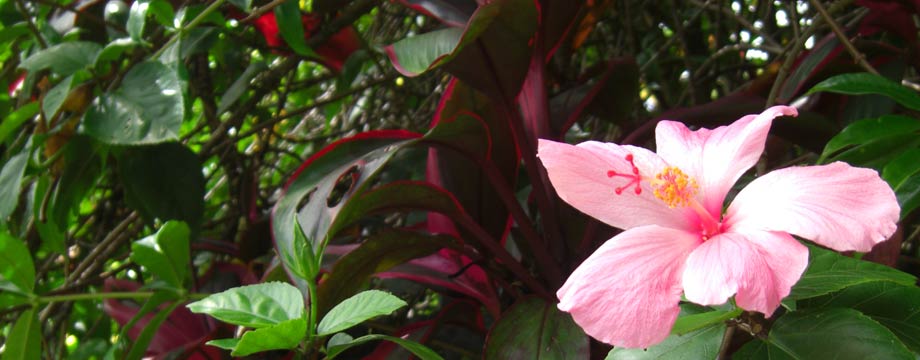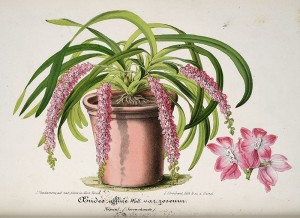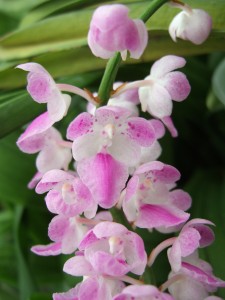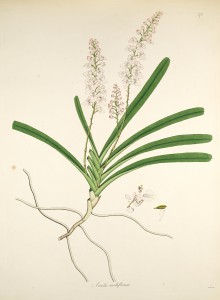Species Description
Aerides rosea is a “magnificent free-flowering Indian species, of which there are many varieties both in growth and flowers, and which is popularly known as the fox-brush Aerides; it grows from two to three feet high; some of the varieties have dark green foliage, while others are of a lighter shade; the leaves, which are broad, are eight or ten inches long; the spikes sometimes attain a length of three feet, and are branched; the flowers are clear bright rose colour, unusually large, and are produced during May, June, and July, continuing in bloom three or four weeks. A beautiful dwarf species from India, producing leaves a foot long, spotted with brown. It is a slow-growing plant, bearing light rose-coloured flowers, spotted with a darker shade of the same colour. This plant, which does not root freely, requires less moisture than any of the other kinds. This makes a fine exhibition plant.” (From the Classic Orchid Grower’s Manual by B.S. Williams.)
Varieties and Cultivars
Aerides rosea superbum is a “fine variety, much stronger in growth than Aerides rosea; the flowers also larger, and of a richer colour. The best variety I ever saw bloomed with Mr. B. Findlay, at the Botanic Garden, Manchester. The spikes of this, as well as those of the species, are apt to damp off at the ends before the flowers open—an evil which is often caused by too much moisture having been given. It continues a long time in perfection.” (Source: Classic Orchid Grower’s Manual.)
Aerides rosea williamsii.Benjamin S. Williams describes this species uder the synonym Aerides williamsii as a “distinct and charming kind from India, with broad dark green drooping foliage. The spikes of flower are produced in great abundance, measuring from two to three feet in length, and branched; colour, pinkish white; very scarce. First flowered in the collection of the late C. B. Warner, Esq.; blooms in June and July, and makes a fine Orchid for purposes of exhibition, on account of its free flowering character; from its delicate colour it also associates well with other kinds.” (Source: Classic Orchid Grower’s Manual.)
Synonyms
- Aerides fieldingii
- Aerides williamsii
Publications
- “L’Illustration horticole”: journal special des serres et des jardins, ou choix raisonne des plantes les plus interressantes sous le rapport ornemental, comprenant leur histoire complete, leur description compareé, leur figure et leur culture / redige par Ch. Lemaire. V.3 , pl. 88
- Classic Orchid Grower’s Manual













